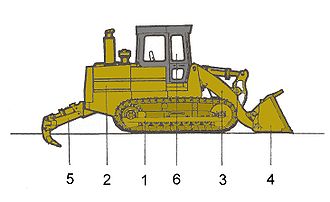Crawler loader
The crawler loader (also called caterpillar loader or chain loader ) is a construction machine that is mainly used in earthworks . It has a crawler chassis and is equipped with a loading shovel at the front. The similarity to the bulldozer is unmistakable , but the crawler loader is more of a modification of the wheel loader . The crawler loader differs from the wheel loader in its better off-road mobility and in its ability to better loosen densely packed soils.
history
The development of the crawler loader began after the Second World War. First, the bulldozer's shield was removed and exchanged for a loading shovel with a lifting frame. The bulldozer as a basic device was only partially suitable as a crawler loader, so that own devices were developed. These received a better weight distribution and a better overview for the operator. For this purpose, the engine was moved to the rear and the driver's cab moved to the center of the machine. In this way the weight of the engine could serve as a counterweight during the loading operation.
Components
The crawler loader essentially consists of six components:
- Chain drive
- engine
- Lifting frame with Z-kinematics
- Front attachment (loading shovel)
- Rear attachment (rear ripper)
- Driver's cab
Parameters
Depending on the model, the crawler loader receives between 30 and 160 kW of power from the diesel engine . The operating weight is between 5 and 32 t, the loading shovel holds up to 4.0 m³. A tipping height of up to 3.2 is possible. The machine reaches 7 to 11 km / h when empty, and between 3 and 7 km / h under load.
Technology and equipment
The crawler loader is manufactured with a hydrostatic drive. Drives with torque converters and powershift transmissions as well as steering clutches and steering brakes are rarely found in crawler loaders.
In the case of the shovel kinematics, the Z-kinematics has prevailed, since in this case higher breakout forces and more favorable tilt angles can be achieved. The arrangement of the engine in the rear serves as an additional balance stabilizer, which improves the aforementioned factors even further.
A rear ripper can be arranged at the rear of the machine . This is available as a single or multi-tooth ripper.
Depending on the application, the crawler unit can be equipped with different base plates. A distinction is made between 1-, 2- or 3-web designs as well as special sinusoidal peat floor panels that clean themselves.
safety
The statutory accident prevention regulations (short UVV ) for earth moving machinery shall require loaders with both a ROPS protection device ( R oll O ver P rotective S tructure ) and a FOPS protection device ( F alling O bject P rotective S tructure must be provided). The latter is only to be attached to machines that are used in the quarry or when demolishing buildings .
The driver of a crawler loader must have been instructed, be physically and mentally fit and at least 18 years old. The device cannot be used on public roads due to its chain drives. The transport to the place of use takes place with the help of a low loader .
Manufacturer
Crawler loaders are produced by various manufacturers, including well-known companies such as Liebherr , Caterpillar or Komatsu . Their distribution is different. The crawler loader is very popular in the United States and Switzerland, but is rarely found in Germany.
See also
literature
- General
- Willi Dolder: 1000 excavators and other construction machines , NGV-Verlag, 2006, ISBN 978-3-625-10374-5
- Germany
- UVV "vehicles"
- BGR "Operation of work equipment"
- VGB 40 "Excavators, loaders, graders, scrapers and special machines for earthworks (earth-moving machines)"
- Europe
- DIN EN 474-1 "Earth-moving machines"
Web links
Individual evidence
- ↑ Manfred Hoffmann: Number tables for construction operations , Teubner Verlag, 2006, ISBN 3-519-65220-X , page 619
- ^ Willi Dolder: 1000 excavators and other construction machinery , NGV-Verlag, 2006, ISBN 978-3-625-10374-5 , page 34



